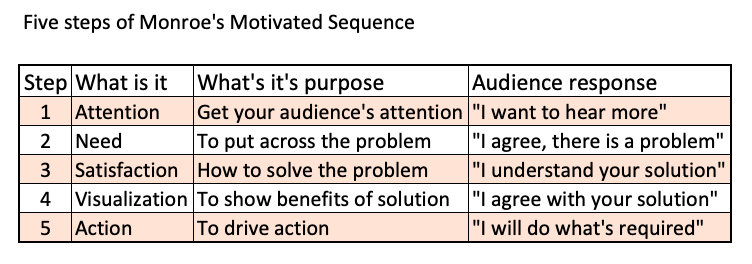
In this article, we’re going look at Monroes Motivated Sequence, which is a method of structuring communication to motivate an audience to take action.
In the article, we’ll have a look at
- The structure of the method and how to apply it.
- Pro’s and Cons of the method
- Alternatives to the sequence
The Powerpoint trap. What makes presentations ineffective
I’m sure like me that you’ve had to give presentations and talks during your career. Most of us resort to the trusty old Powerpoint slides.
Having spent hours crafting our words and layout, when we’re stood in front of our audience, we regurgitate what’s on our slides (Hint: our audience can read too!). Is it any wonder why many of your audience switches off?
Many of us fall into the trap of creating our powerpoint in the following way;
- We include a bunch of random stuff about our issue,
- We don’t pay sufficient regard to chronology or order,
- We focus our presentation about presenting facts/information – most of which the audience probably know already
- We don’t engage our audience with what matters to them
- We don’t make the call to action clear
Unsurprisingly, we don’t motivate our audience.
Communicating effectively without a method, to an audience is hard; obtaining their buy-in and encouraging them to do something is harder still.
The good news is that we can help ourselves by adopting a method (such as Monroe’s Motivated Sequence).
Systems and Methods help by looking at:
- How the information is framed/structured
- How the information is communicated
- How the audience relates to it
What is Monroe’s Motivational Sequence
Alan H. Monroe developed the method in the 1930s stating, “When confronted with a problem that disturbs their normal orientation, they (people) look for a solution; when they feel a want or need, they search for a way to satisfy it.”
Monroe’s sequence looks to structure the communication in such a way that the audience feels the need in engaging with solutions when presented with problems.
His method features a five-step persuasive speech sequence, structured to communicate a problem to your audience and motivate them to take action.
Communication skills that help you construct persuasive arguments are a powerful tool. As it’s unlikely that we will look to communicate or present to an audience just the once, having something that we can call upon that we know works represents a compelling argument to utilize it.
The five steps, which we’ll go into detail on later, are:
- 1/ Attention
- 2/ Establish the need
- 3/ Satisfy the need
- 4/ Visualize the future
- 5/ Call to action
The steps can be seen in the graphic below:

Monroes Motivated Sequence is effective for several reasons:
- It’s simple,
- It’s repeatable,
- It is based on the universal desire to solve problems that can be extended into any number of situations or business environments.
What are the five steps of Monroes Motivated Sequence?
We’ve summarised the five steps in the table below, together with steps purpose and the response required from the audience.

Let’s take a look at the steps in a bit more detail and how to utilize them.
Step 1: Attention
In general, people have very short attention spans, so there is a key need early on in the communication process to do three things
- 1/ State your purpose
- 2/ Underpin your credibility
- 3/ Grab the attention of your audience.
Perhaps the key issue here is one of credibility. For many audiences, the key questions are:
- Why should I listen to you?
- Why should I trust you?
Establishing credibility can be achieved through several enablers such as your reputation, demonstrating research, identifying with your audience.
The second challenge is grabbing the audience’s attention, we can use a number of methods for this.
- Posing a question that is important for your audience
- Using shock tactics i.e statements, statistics, targets, etc
- Using drama
- Imagery
Step 2: Establish the Need
The target of step two is that we want our audience to recognize the need for change. We can look to do this by:
- Describing the problem & how it directly affects the audience
- Creating a sense of urgency
- Being clear about the consequences of leaving things as they are
By the end of this step, the audience should:
- Understand the issue
- Understand the impact of the issue
- Require a solution
Step 3: Satisfy the Need
During step two, we created a need for an urgent solution to the problem that we’ve presented, Step 3 will look to put forward a solution.
In step three we will:
- Introduce the solution.
- Illustrate your solution using data and compelling arguments.
- Mitigate objections by putting counterarguments in place
It’s vital that step 3 leaves your audience with a clear understanding of your plan.
Step 4: Visualize the Future
There are three methods that we can use for this step:
- Positive Method: Describe the future state if your proposals were adopted plan is selected.
- Negative Method: Paint a negative picture and describe the future state if your proposals are not adopted. Use data and present estimated forecasts.
- Contrast Method: Contrast the negative method with the positive method.
Use data responsibly, providing future views that are realistic and cannot be easily challenged. It’s not wise to appear a charlatan so do not paint a picture that is false, as you’ll find yourself easily shot down and debunked.
Step 5: Call to Action
In the final step, you need to present your plan and what you want your audience to do. This could be a variety of things including: taking key actions, doing nothing, lobbying key members of your organization.
Whatever the call to action you desire from your audience, be sure to make it clear and easily understandable.
Monroe’s Motivational Sequence vs Death by Powerpoint
Hopefully, you can see how the method contrasts with traditional communication methods that we described in our introduction.
Replacing presenting facts/information with taking your audience on a journey that ends with them engaged in the topic and wanting to take action is the key difference to a traditional powerpoint.
Note that the method doesn’t solve all your issues. For example, you’ll still need to:
- Prepare
- Have relevant visuals/slides
- Know your audience. …
- Underpin your credibility by dressing appropriately, arriving on time, being polite and respectful to your audience
- Avoid speaking like a robot in a monotone voice.
But issues like these are the basics. You still need to do the ground work; the method merely provides you with a way of structuring your work to drive a compelling argument to your audience.
Common alternative to Monroe’s Motivational Sequence
Remember that Monroe’s system is just one method, there are a variety of presentational styles and techniques that can be utilized.
Let’s take a look, briefly, at another common alternative that you’ve probably utilized.
This is the “tell them what you’ve been told, repeat it and then repeat it again” approach.
The structure of these presentations tends to be:
- An introduction to what is going to be discussed.
- The main presentation, featuring the information
- A summary that highlights the main points of what you’ve put across.
As a structure, it provides several benefits:
- It’s a natural structure to remember/apply
- It repeats the main facts to your audience (many times so it sinks in!)
- It’s familiar to your audience.
The problems associated with this method are:
- It usually presents what’s important to you rather than what’s essential to your audience
- It doesn’t often engage with them or compel them to do anything.
- It can be repetitive and often compels the audience to switch off.
Summary
We can all do with improving our communication skills.
Monroe’s motivational sequence can offer us a repeatable tool that we can use to help us do this.
The tool helps to garner attention and obtain buy-in, by following a method of communicating to our audience.
We hope that you’ve enjoyed this article on the subject and that you’ll take a look at your presentational styles and how you can look to develop them.
Perhaps you’ve used Monroe’s technique or have other methods that you’d like to put forward? As ever we’d love some feedback, feel free to use the comments section below or to fire us a message on twitter.
This page is part of our Management & Leadership Guide which is full of great leadership tips, methods and templates.